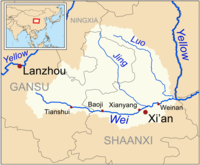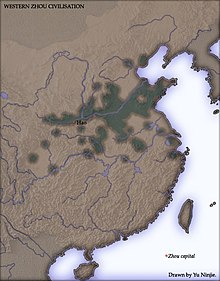Wei River

The Wei River (Chinese: 渭河; pinyin: Wèi Hé; Wade–Giles: Wei Ho) is a major river in west-central China's Gansu and Shaanxi provinces. It is the largest tributary of the Yellow River and very important in the early development of Chinese civilization.[1]
The source of the Wei River is close to Weiyuan County – Wei yuan meaning "Wei's source" – in Gansu province, less than 200 kilometres (120 mi) from the Yellow River at Lanzhou. However, due to the sharp turn north the Yellow River takes in Lanzhou, the Wei and the Yellow River do not meet for more than 2,000 kilometres (1,200 mi) further along the Yellow River's course. In a direct line, the Wei's source lies 700 kilometres (430 mi) west of the main city along its course, Xi'an in Shaanxi province. The length of the river is 818 kilometres (508 mi) and the area drained covers 135,000 square kilometres (52,000 sq mi).
The Wei River's tributaries include the Luo River, Jing River, Niutou River, Feng River and the Chishui River.
The Wei River valley has a continental climate, with hot summers and cool, dry winters. It sits between the arid steppes and deserts to the north and the forests of the Qingling mountains. Its natural vegetation would be a steppe-forest, but it has been transformed by human activity and is mostly agricultural.[2]
History

In Chinese mythology, the giant Kua Fu drained the Yellow River and the Wei River to quench his burning thirst as he pursued the Sun.[3] The valley of the Wei was one of the early cradles of Chinese civilization, along which the capitals of the Zhou, Qin, Han, and Tang dynasties were situated. The area of Dingxi around its headwaters in Gansu has numerous Stone Age sites from various early cultures. The Wei Valley is likely the earliest center of Chinese civilization, and also the location of China's first major irrigation works.[4] Some Chinese historians now believe the Wei is the ancient Jiang River that gave its name to the families of Shennong and the Yan emperor, two Chinese legendary heroes credited with the early development of agriculture there.[5]
As "China's natural gateway" to the west,[6] the headwaters of the Wei River are also notable in the development of the Northern Silk Road. The Chinese segment of the Northern Silk Road connected Chang'an (then the capital of China) to the west via Baoji, Tianshui at the Wei's headwaters, Lanzhou, Dunhuang, and the Wushao Ling Mountain, before looping north of the Taklamakan on its way to Kashgar and the routes into Parthia.[7]
The Wei River Bridge (Weihe Qiao 渭河桥) featured in the design of the 5000-yuan note of the first series of the renminbi, dated 1953, and shows a train passing over the bridge.[better source needed]
Construction of the Sanmenxia Dam in 1960 caused extensive sedimentation problems in the lower reaches of the Wei river.[8] The construction of the Baojixia diversion works in 1972 and the creation of the Baojixia Irrigation District, with 128,000 hectares (490 sq mi) of cropland under irrigation have resulted in reduced flows.[9][10]
In September 2003 extensive rainfall led to flooding that caused over 30 fatalities, and temporarily displaced over 300,000 people.[11] Ecological aspects of the Wei River have been examined with respect to flow rates in the Wei River.[12]
See also
References
- ^ "Wei-River Gansu". Wei-River-Gansu-and-Shaanxi-provinces-China.
- ^ Lander, Brian (2020). "Birds and Beasts Were Many: the Ecology and Climate of The Guanzhong Basin in the Pre-Imperial Period". Early China. 43: 207–245. doi:10.1017/eac.2020.10. S2CID 229042388.
- ^ Summary of the story given in the definition of "夸父追日" in 《现代汉语词典》 [Contemporary Chinese Dictionary] (in Chinese) (7th ed.). Beijing: The Commercial Press. 2016-09-01. pp. 513, 755. ISBN 978-7-100-12450-8.
- ^ Encyclopædia Britannica Online Concise
- ^ Pulleybank, Edwin G. (2000). "Ji 姬 and Jiang 姜: The Role of Exogamic Clans in the Organization of the Zhou Polity". Early China. 25: 1–27. doi:10.1017/S0362502800004259. S2CID 162159081.
- ^ Barger, Evert (1939). "Exploration of Ancient Sites in Northern Afghanistan". The Geographical Journal. 93 (5): 377–391. doi:10.2307/1788707. JSTOR 1788707.
- ^ Hogan, C. Michael. "Silk Road, North China". The Megalithic Portal. ed. Andy Burnham.
- ^ "陕西省东庄水利枢纽工程建设有限公司". www.dzhwater.cn. Retrieved 2022-04-11.
- ^ Wu, W.; Xu, Z. X.; Liu, X. C. (2012-01-01). "Impact of Baojixia water diversion works on the hydrologic regime in the Wei River basin". Procedia Environmental Sciences. 18th Biennial ISEM Conference on Ecological Modelling for Global Change and Coupled Human and Natural System. 13: 1653–1662. doi:10.1016/j.proenv.2012.01.158. ISSN 1878-0296.
- ^ Wang, Jichao; Gao, Xuerui; Huang, Kejing; Yuan, Yujie; Wang, Ai; Dong, Leihua; Zhao, Xining (2023-02-01). "A remote sensing-based method for high-resolution crop water footprint quantification in an irrigation district with complex planting structure". Journal of Hydrology. 617: 129030. doi:10.1016/j.jhydrol.2022.129030. ISSN 0022-1694.
- ^ "17,000 Houses Collapse, 200,000 Evacuated in Flood-Hit China, Agence France-Presse 2 sept 03". Archived from the original on 2006-02-10. Retrieved 2006-03-21.
- ^ J. X. Song; Z. X. Xu; C. M. Liu; H. E. Li (2007). "Ecological and environmental instream flow requirements for the Wei River—the largest tributary of the Yellow River". Hydrological Processes. 21 (8): 1066–1073. Bibcode:2007HyPr...21.1066S. doi:10.1002/hyp.6287. S2CID 128419416.
